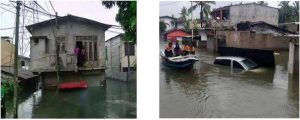Menu Niluskshika, deputy WWC Asia Coordinator reports on the consequences of a tropical storm in Sri Lanka:
On 15 May 2016 Sri Lanka was hit by a severe tropical storm that caused widespread flooding and landslides in 22 districts of the country destroying homes and submerging entire villages. At least 84 people are known to have died as a result of Tropical Storm Roanu and a further 116 people are still missing, many as the result of a landslide that struck Aranayake, Kegalle district on 17 May 2016; this was followed by a second landslide in the same area four days later and landslides warning remain in place in nine areas of the country.
Currently 237,240 people are displaced from their homes and living in a variety of safe locations including camps, schools, temples, with host families and in other temporary accommodation. The majority of these displaced people are in Colombo and Gampaha districts in the south-west of the country where floodwaters still remain high. As a result of heavy rains, several major reservoirs overflowed and flood gates were fully opened to avoid a dam breach, causing flooding downstream. Areas downstream of two large rivers to the north and south of the capital city Colombo, the Kelani river and the Kalu river, remain flooded with the possibility of further floodwaters flowing from upstream areas should heavy rains persist.
It is expected to take several days for floodwaters to recede and in some areas water levels remain as high as the roofs of people’s houses with access only possible by boat or by air. Many of the affected population, particularly in the rural areas, were already amongst the most vulnerable in the country and have now lost everything, including their homes, possessions, agricultural land and means of making a living. In the urban areas there are growing health concerns related to the quantity of so much standing water in highly populated areas and the destruction of much of the water and sanitation infrastructure, which could lead to serious public health issues. The Government of Sri Lanka is leading the response to the floods; Tri Forces are fully engaged in search and rescue, and evacuation missions as well as distributing relief items to those people still trapped by the flood waters, and the Sri Lankan Army are working to recover the bodies of those missing in the Aranayake landslide. Local organisations, faith groups, youth groups and businesses are actively involved in the provision of aid. Priority needs are for WASH, health, shelter and food assistance, and current requests include the provision of emergency items including clothing, water purification tablets, temporary latrines, hygiene and cooking equipment.
Download:
160602 Floods and Landslides Situation Report in Sri Lanka – EN

